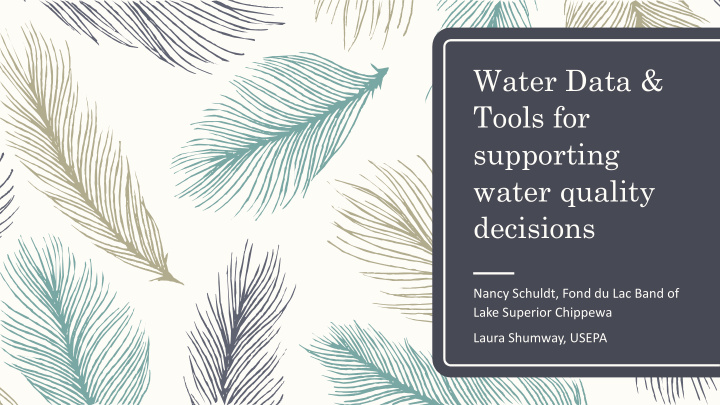



Water Data & Tools for supporting water quality decisions Nancy Schuldt, Fond du Lac Band of Lake Superior Chippewa Laura Shumway, USEPA
Water Data Tools Tool Name Tool Functionality Program Support Where to find the tool E-Enterprise Tribal A tribe can answer 6 questions about their water program Helps a tribe submit data to https://epa.gov/storet – Roadmap for WQX and the generates a custom guide for submitting data to WQX E-Enterprise tribal submissions WQX. There is also charting functionality in the tool to help roadmap for WQX tribes see what sampling has occurred and what the results Submissions are. SP14b Analysis Helps tribes retrieve data that has been submitted to WQX This tool can be used to help https://epa.gov/storet – Tool and perform simple criteria comparisons. It was developed tribes create Assessment WQX excel analysis tool to support tribes reporting on measure SP14b but is useful Reports and can generate a to other water quality assessments. map of your monitoring locations Water Quality This tool helps a user retrieve data from the water quality This tool can be used to create https://epa.gov/storet – Portal Data portal and prepare it for complex data analyses. The tool assessment reports Water Quality Portal Data Discovery Tool also has basic graph and chart functionality. A User needs to Discovery Tool have R software Data Analysis Tool This tool is a secondary tool to the Water Quality Portal This tool can be used to make COMING SOON! Discovery Tool. A user uploads data they filtered through the assessment decisions. The Data discovery tool to then assess the data against tribal output of this tool will be WQS or benchmark criteria. A user needs to have R software ATTAINS compatible ATTAINS The database which holds water quality decisions. The use This tool can be used in-lieu of COMING SOON! of this database is being piloted in 2017 & 2018 Assessment Reports
Tribal Roadmap
Customized Tribal Water Quality Data Guide Business Process Improvement- 30 to 6 pages
SP14b Analysis Tool
Data Discovery Tool
Data Analysis Tool
Data Analysis Tool
Data Analysis Tool
ATTAINS pilot project Questions leading to the project: 1. What is the status of water quality on tribal lands locally, regionally, & nationally? Most Regions capture data in a word document which makes it difficult to capture trends through time on individual tribal lands and – makes it difficult to tell the whole story of water quality of tribal lands regionally and nationally. 2. What standard format and information do all tribes provide in their Assessment Reports? – The 106 guidance provides a good guideline for reporting but regions implement the process differently. 3. How can we help tribes prepare for CWA Authority 303(d)? – Tribes will have to report assessment data to ATTAINS if they take on TAS for 303(d). How can we help prepare them for that change? 4. How can we create program measures that are truly representative of the water quality on tribal lands? – Current tribal water quality measures are representative of tribes and regions time to participate rather than the true quality of waters on tribal lands. 5. How can we make assessment reporting more streamlined? – We can standardize assessment decision reporting in the system and each region can review the decisions in the same environment.
What’s been done? 1. Region 6 tribes and EPA developed a workgroup to determine how they could address the issues in the region. 2. The Region 6 tribes and EPA worked together to develop a proposal to report water quality through ATTAINS. ( A ssessment and T MDL T racking A nd I nformatio N S ystem – used for reporting water quality decisions) 3. The region 6 RTOC approved the pursuance of the proposal and approved the kick-off of the training following the November RTOC in region 6. 4. Region 5 will have 1 participant and Region 9 will have 4 participants in the pilot project to get a broader via of e-reporting requirements and implications due to the unique regional approaches to water quality reporting. Region 6 tribes are still pending. 5. Pilot project notice and call for participants was just sent out. 15 tribes responded Workgroup kick-off call began Oct 3 rd . 6.
What’s next? – Workgroup will meet 2-3 times before Dec training – Pilot tribal participants will meet in Dec following the Region 6 RTOC for a workshop on assessment program implementation – The workgroup will work on assessment methodologies, ATTAINS system review, TAS for 303(d), the Water Quality Portal data analysis tool, and data display & communication. – Pilot tribal participants will attend the ATTAINS technical training the Summer of 2017 – Pilot tribes will continue to participate for at least the 2018 reporting year – Workgroup will evaluate the project and decide whether it should be proposed for adoption nationally.
ATTAINS DEMO
Questions – Tribal Lead : Micco Emarthla memarthla@sctribe.com – Region 6 Lead : TeAndra Taylor Taylor.TeAndra@epa.gov – Region 5 Lead : David Horak Horak.david@epa.gobv – Region 9 Lead : Audrey Johnson Johnson.AudreyL@epa.gov – HQ Lead : Laura Shumway Shumway.laura@epa.gov
Recommend
More recommend